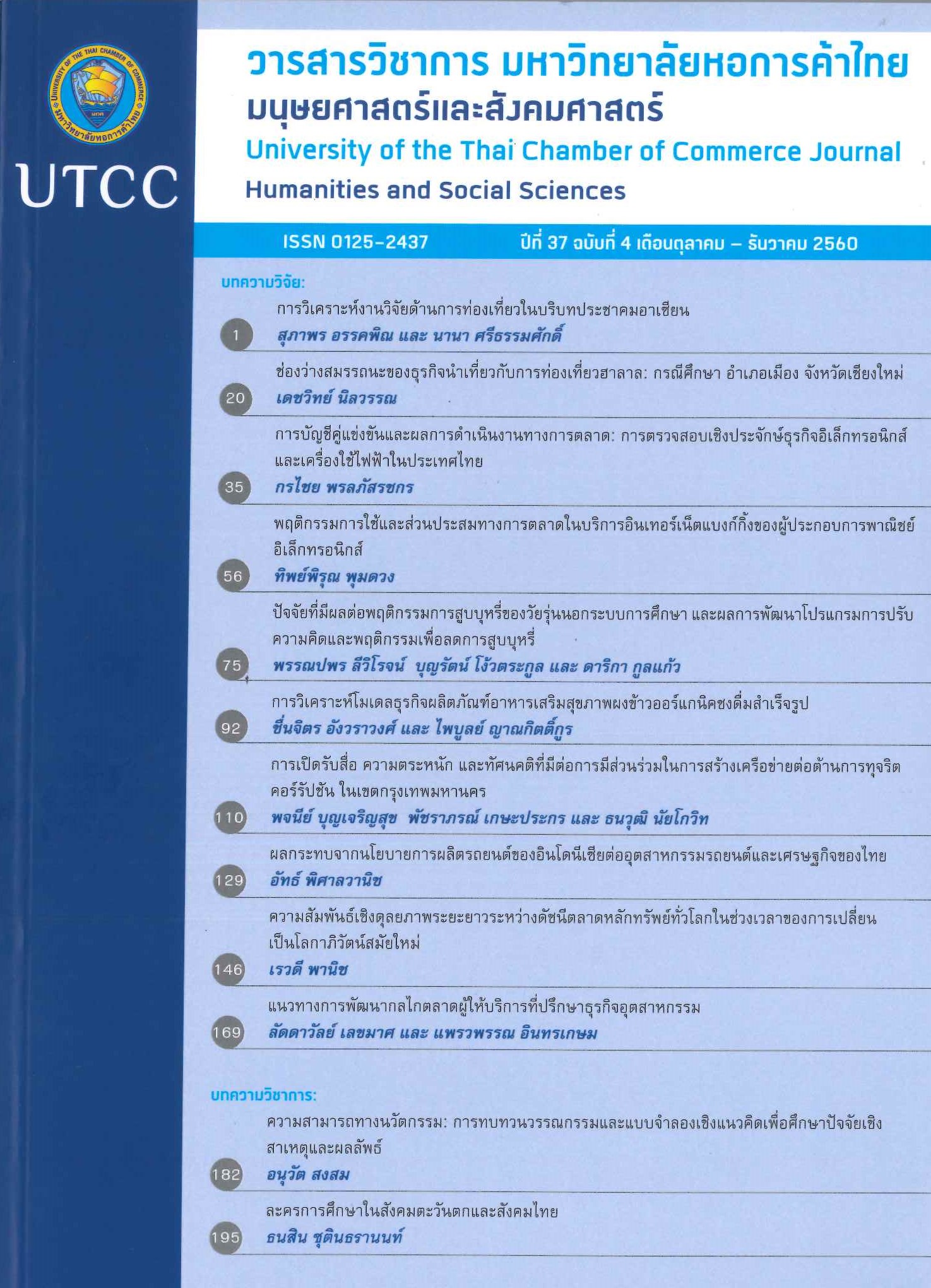ความสัมพันธ์เชิงดุลยภาพระยะยาวระหว่างดัชนีตลาดหลักทรัพย์ทั่วโลกในช่วงเวลาของการเปลี่ยนเป็นโลกาภิวัฒน์สมัยใหม่
Main Article Content
บทคัดย่อ
งานศึกษานี้มีวัตถุประสงค์เพื่อศึกษาความสัมพันธ์ระหว่างตลาดหลักทรัพย์ทั่วโลกในกลุ่มประเทศที่พัฒนาแล้ว 7 ประเทศและกลุ่มประเทศที่กำลังพัฒนาและเกิดใหม่อีก 5 ประเทศ ในช่วงเวลาของการเปลี่ยนเป็นโลกาภิวัตน์สมัยใหม่ ทั้งนี้ มีการใช้ข้อมูลดัชนีราคาหุ้นรายเดือนเพื่อทดสอบความสัมพันธ์เชิงดุลยภาพระยะยาวและการปรับตัวระยะสั้นเพื่อให้เข้าสู่ดุลยภาพระยะยาว ตามแนวคิดของ Johansen (1988) โดยในยุคก่อนโลกาภิวัตน์ (1976-1990) พบความสัมพันธ์เชิงดุลยภาพระยะยาว 4 รูปแบบ คือตลาดอเมริกา (DJIA)เยอรมัน (DAX) ฮ่องกง (HSI) และมาเลเซีย (KLS) สัมพันธ์กับตลาดญี่ปุ่น (NKY) เกาหลีใต้ (KS11) ไทย(SET) ไต้หวัน (TWSE) และหากมีการเบี่ยงเบนออกจากความสัมพันธ์ระยะยาว NKY และ TWSE จะเป็นตลาดที่ปรับตัวระยะสั้นเพื่อให้เข้าสู่ดุลยภาพระยะยาวได้ส่วนในยุคโลกาภิวัตน์สมัยใหม่ (1990-2016) พบความสัมพันธ์เชิงดุลยภาพระยะยาว 2 รูปแบบ คือ ตลาด DJIA และ DAX สัมพันธ์กับตลาด FTSE, HSI, JKSE, KLS, STIและ TWSE โดย KLS, KS11, PSE, SET และ TWSE สามารถปรับตัวในระยะสั้นเพื่อให้เข้าสู่ดุลยภาพระยะยาวได้ทั้ง 2 รูปแบบ ดังนั้น ภายใต้ความสัมพันธ์ระหว่างตลาดหลักทรัพย์ในช่วงเปลี่ยนแปลงเป็นโลกาภิวัตน์สมัยใหม่ พบว่า ตลาดอเมริกาและยุโรปส่งผลกระทบต่อตลาดเอเชียและตลาดเกิดใหม่ทุกตลาด
Article Details
ลิขสิทธิ์ของบทความ
ผลงานที่ได้รับการตีพิมพ์ถือเป็นลิขสิทธิ์ของมหาวิทยาลัยหอการค้าไทย ห้ามมิให้นำเนื้อหา ทัศนะ หรือข้อคิดเห็นใด ๆ ของผลงานไปทำซ้ำ ดัดแปลง หรือเผยแพร่ ไม่ว่าทั้งหมดหรือบางส่วนโดยไม่ได้รับอนุญาตเป็นลายลักษณ์อักษรจากมหาวิทยาลัยหอการค้าไทยก่อน
เอกสารอ้างอิง
Charoenkidhutakorn, K. (2005). The relationship between the stock exchange of Thailand index and the major indexes of the United States of America (Unpublished master’s
independent study). Chiang Mai University,Thailand. (in Thai).
Engle, R. F., & Granger, C. W. J. (1987). Cointegration and error correction: Representation, estimation and testing. Econometrica, 55(2), 251-276
Granger, C. W. J. (1981). Some properties of time series data and their use in econometric models specification. Journal of Econometrics, 16(1), 121-130.
Johansen, S. (1988). Statistical analysis of cointegration vectors. Journal of Economic Dynamic and Control 12(2-3), 231-254.
Johansen, S. (1995). Likelihood-based inference in cointegration vector autoregressive model. New York, NY: Oxford University Press.
Markowitz, H. M. (1987). Mean-variance analysis in portfolio choice and capital market. New York, NY: Blackwell.
Masih, A. M. M., & Masih, R. (1997). Modelling the dynamic linkages and the propagation Mechanism among major international stock markets: Empirical evidence from
the pre- and post-crash eras based on a multivariate cointegration/VECM approach. Quarterly Review of Economics and Finance, 37(4), 859-885
Masih, A. M. M., & Masih, R. (2002). Propagative causal price transmission among international stock market: evidence from the pre- and post-globalization period. Global Finance Journal, 13(1), 63-91.
Masih, R., & Masih, A. M. M. (2001). Long and short term dynamic causal transmission amongst international stock market. Journal of International Money and Finance, 20(4), 563-587.
Ophaschaowarit, N. (2005). The relationship between the stock exchange of Thailand index and The major indexes in European (Unpublished master’s independent
study). Chiang Mai University, Thailand. (in Thai).
Pradeeppawanij, R. (2011). Analysis of the relationship between the indexes of Thailand with the members of ASEAN (Unpublished master’s independentstudy). Bangkok University, Thailand. (in Thai)
Rangkakulnuwat, P. (2001). The demand of money in Thailand before and after the change in the exchange rate system: Error correction model. University of the
Thai Chamber of Commerce Journal, 21(3), 25-44. (in Thai).
Rangkakulnuwat, P. (2008). Determinant of foreign direct investment in ASEAN. University of the Thai Chamber of Commerce Journal, 28(1), 99-107. (in Thai).
Rangkakulnuwat, P. (2013). Time series analysis for economics and business. Bangkok, Thailand: Chulalongkorn University Press. (in Thai).
Ratanasumritkul, S., & Banchuenwijit, W. (2008). The relationship between the index prices, Stock Exchange of Thailand and the stock price index, foreign
exchange (Unpublished master’s independent study). University of the Thai Chamber of Commerce, Bangkok, Thailand. (in Thai).
Sheng, H.-C., & Tu, A. H. (2000). A study of cointegration and variance decomposition among national equity indices before and during the period of the Asian financial
crisis. Journal of Multinational Financial Management, 10(3-4), 345-365.
Somngam, P. (2003). The relationship between the stock exchange of Thailand index and the major index in Asia (Unpublished master’s independent study). Chiang Mai University, Thailand. (in Thai).
Uaapisitwong, T. (2007). The relationship between the stock exchange of Thailand index and the major indexes of the world (Unpublished master’s independentstudy). Chiang Mai University, Thailand. (in Thai).
Valadkhani, A., & Chancharat, S. (2008). Dynamic linkages between Thai and international stock markets. Journal of Economic Studies, 35(5): 425-441.
Wichairat, W. (2006). The relationship between the stock exchange of Thailand index and the major indexes in Oceania (Unpublished master’s independentstudy). Chiang Mai University, Thailand. (in Thai).
Wong, W.-K., Penm, J., Terrell, R. D., & Lim, K.Y. C. (2004). The relationship between stock market of major developed countries and Asian emerging markets. Journal of Applied Mathematics and Decision Sciences, 8(4): 201-2180


